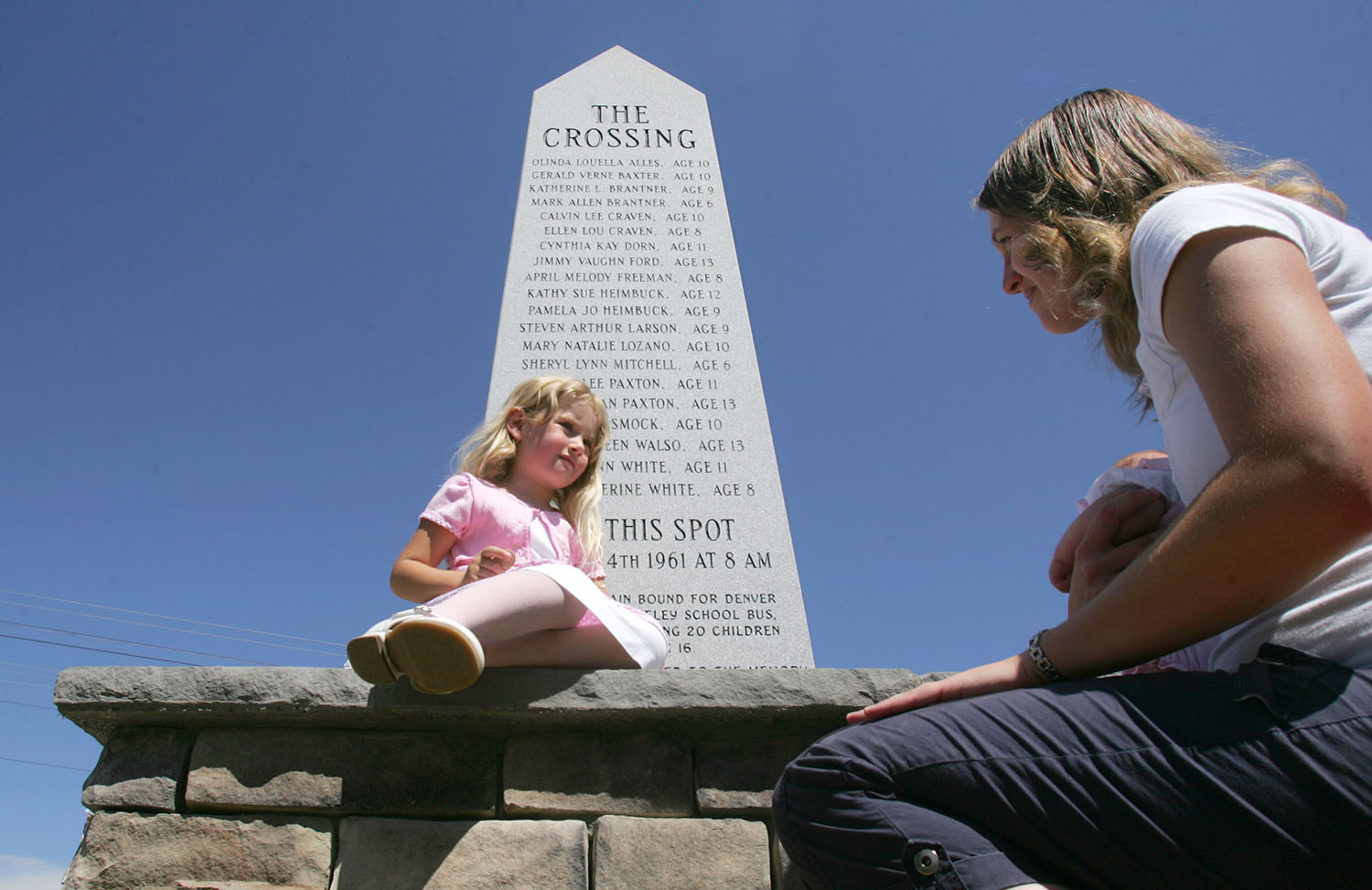
FROM THE PUBLISHER
From N.M. to Greeley, a lighted path
September 1, 2007
By John Temple
Rocky Mountain News

CHRIS SCHNEIDER /ROCKY MOUNTAIN NEWS
Brandie Fabian, right, granddaughter of Katherine Brantner, talks with her daughter, Grace, 4, at the site of The Crossing memorial near Greeley last week. Brantner lost two children, Mark and Kathy, in the crash.
I never imagined that one day I would stand under the sweeping Colorado sky, along a railway track, in a hot field, tears welling in my eyes.
For years I have known, though, that one day I would wake up to hear that the newspaper where I got my start, the place where I learned what a paper can be, was on life support, with its chances of revival about as likely as buying a winning Powerball ticket.
This is a column about two strands of my life and my belief that one wouldn't have been possible without the other, a column about what a newspaper can mean.
It starts on a blazing Sunday morning outside Greeley, where almost 46 years after the worst traffic accident in Colorado history, hundreds gathered to remember 20 children lost on a freezing winter morning when a speeding passenger train cut through a school bus.
It's a place hard to describe. A dirt road. A cornfield. But that's just what's visible. It's what's inside the folks around me — the mothers and fathers, sisters and brothers, friends, neighbors and strangers — that's important.
They're there because on this day a monument is to be unveiled, a spire carved with the children's names and ages, a stone that makes visible the pain carried for too many years. Above the names are written two words: The Crossing.
The Crossing was the name of the 34-part Rocky Mountain News series published early this year that told the story of Dec. 14, 1961, and how it has reverberated through generations. We never imagined, when reporter Kevin Vaughan and photographer Chris Schneider were crisscrossing the country a year ago, that their work would lead to this.
The day was possible only because of the courage of the survivors, the children who made it off the bus and the families of those who never came home. They trusted us, and shared their stories. And now we stood together, the sound of Amazing Grace lifting our spirits.
Many came up to me after the brief ceremony and said, "Thank you." Yes, thank you for what the Rocky had done, what the journalists' stories had made possible.
As Judith and I drove home, I told her it was a day I would always remember, a day to hold on to because it revealed what our work can mean.
Two days later came the news I had always dreaded: "E.W. Scripps Company is seeking a buyer for The Albuquerque Tribune, and said it will close the city's afternoon newspaper if one cannot be found."
It was in 1984 that I walked into the Tribune's old downtown newsroom, a windowless box where I shared a desk next to the men's room. And when I say next I mean so close that I could push open the door without ever getting up.
I can't imagine a better place to begin a journalism career, because at an afternoon newspaper we knew we had to do something different in a town that had a morning newspaper, too. We had to move a story forward or give behind-the-scenes insight. We had to provide something people couldn't get anywhere else. That made us try harder.
Although the Tribune was dwarfed by its larger morning competitor, the Albuquerque Journal, it never thought of itself as No. 2. It's a paper that to this day has huge ambitions, a paper where journalists are encouraged to dream, the way Kevin Vaughan dreamed when he walked into my Denver office and said he thought it would be important to tell the story of the bus crash.
It was my experience at The Tribune that taught me how to respond. It was there I had learned what's possible if only we dream.
As Michael Arrieta-Walden, one of my former colleagues, wrote, The Tribune was "about making a difference, saving lives and making New Mexico a better place."
Well, it was actually about a lot more than that. It was about fun, about camaraderie, about great writing and photography. But his lofty language is accurate.
A newspaper can make a difference. It's The Tribune that gave Scripps, the company that also owns the Rocky, its motto: Give light and the people will find their own way.
The paper's light may go out soon. But many of us around the country have carried our own flickering torch lit there.
I never imagined when I walked into The Tribune's newsroom 23 years ago that it would lead me to the field outside Greeley.
I will always be grateful for the journey and for the little newspaper that showed me what's possible, if only we dream.
Next: Larson backed driver in deadly bus-train crash — Oct. 1, 2007

CHRIS SCHNEIDER /ROCKY MOUNTAIN NEWS
Brandie Fabian, right, granddaughter of Katherine Brantner, talks with her daughter, Grace, 4, at the site of The Crossing memorial near Greeley last week. Brantner lost two children, Mark and Kathy, in the crash.
Back to Index